Sometimes I write things about Red Dwarf which could be considered vaguely useful. Other times, I obsess about a door.
This door, to be exact. Hi there.
Sometimes I write things about Red Dwarf which could be considered vaguely useful. Other times, I obsess about a door.
This door, to be exact. Hi there.
Sometimes, when you hear what has become a well-worn anecdote about a TV show, you wonder whether it’s actually true or not. Other times, you have absolutely no doubt that it’s true. You just want to know more.
Red Dwarf has a great many of these tales. And something I’ve wondered for many years concerns the electricians’ strike which meant that the original recordings for Series 1 had to be abandoned. This has been told in many forms for years; for example, in the “Launching Red Dwarf” documentary on the Series 1 DVD in 2002, commissioner Peter Ridsdale-Scott had this to say:
“The worries were legion. First of all, we had the strike, which meant that every single episode of Red Dwarf of that first series went into production, into rehearsal, and never went into the studio. All six of them. So we’d spent all the money, and the BBC said ‘Well, sorry about this, it’s been very good and we’re sure it would have been a success, but that’s it’. And Paul [Jackson] and I said ‘Oh no. We may have spent the money, but we must remount this production, we must get it on.’ And we persuaded them, and it was put on.”
The same story is told on the official Red Dwarf site1:
“On the second day of rehearsals, an electrician’s strike began at the BBC which effectively put a stop to any production. Unperturbed, the crew completed rehearsals for the first episode and moved on to the second, optimistic that they could fit the The End shoot onto the end of the other existing episode slots.
Except one by one, the episode recordings were called off as the strike persisted. The entire season, rehearsed and ready, was left for six months – past the originally intended dates for broadcast – before being remounted.”
All of which is great, and frankly a damn sight more than we get to hear about most sitcoms. But I’m greedy, and I want more. There’s one particular aspect about all this which has never quite been nailed down over the years. And that is: what were the exact dates of the abandoned Red Dwarf recordings for Series 1?
Select the ‘Production’ section. ↩
HOLLY: Emergency. Emergency. There’s an emergency going on.
LISTER: What is it, Hol?
HOLLY: There’s an emergency, Dave. The navicomp’s overheating, and I need your help in the drive room.
RIMMER: Oooh-ooh-ooh!
LISTER: Come in number 169, your time is up. OK, what was I wearing?
RIMMER: Ahhh… that jacket, and that red T-shirt.Lister pulls out his hat and places it back on his head, then yanks a hefty length of piping off the wall.
LISTER: You said yourself, I can’t stop it. Let’s get it over with.
RIMMER: (Pointing at the pipe) Ah, Lister, what’s that for?
LISTER: I’m going out like I came in – screaming and kicking.
RIMMER: You can’t whack Death on the head!
LISTER: If he comes near me I’m gonna rip his nipples off.
Poor old David Lister. “Future Echoes” (RX: 17-18/10/87) is a particularly unpleasant business for him. But as he plugs in the drive computer into the navicomp and faces down Death – with or without nipples – he can at least be sure that he’s starting off a chain of events which makes a sad old Red Dwarf fan very happy.
Let’s back up a bit. Last time we looked at the wonderful word of Red Dwarf props and sets, we managed to trace a couple of EXCITING PANELS from Series 1 in 1987, right through to Series VII in 1996. Frankly, this was a bit too exciting, and I had to have a lie down for a bit.
But when I recovered, I was left sweaty and dissatisfied. To trace part of a set through nearly the entirety of the BBC years, but missing out Series VIII, was absolutely infuriating. Surely there must be something which made the trip through the whole eight series?
The other day, I was browsing some paperwork for the Red Dwarf episode “White Hole” (TX: 7/3/91) , as you do. And something interesting caught my eye.
“This programme was recorded on Composite Betacam SP videotape.
Original tape numbers: 83 – 101 (with tape no: 90 being the master insert audience tape). Tape No: 124 + 126 additional graphics tapes.
Tape no: CV37898 (Mirage FX tape).”
Mirage FX tape? What’s that?
I know that some of you are already screaming at me. I have to admit, I am far from an expert on this kind of thing. I do, however, know enough to throw a few search terms into Google. I think we can trust Wikipedia with the basics, at least.
“The Quantel Mirage, or DVM8000/1 “Digital Video Manipulator”, was a digital real-time video effects processor introduced by Quantel in 1982. It was capable of warping a live video stream by texture mapping it onto an arbitrary three-dimensional shape, around which the viewer could freely rotate or zoom in real-time. It could also interpolate, or morph, between two different shapes. It was considered the first real-time 3D video effects processor.”
I also know that sometimes, the best way to get a grip on the capabilities of things like this is to search for demonstration videos on YouTube. In 2021, we’re in a far better situation than we were even a decade ago with this stuff: so much reference material has been uploaded by some extremely helpful people.
I was not disappointed.
And at 1:38 into that video… oh, that’s the bit they used in “White Hole”. Does that explosion effect remind you of anything?
Yes, when Holly is going through the intelligence compression procedure:
Or to be more specific:
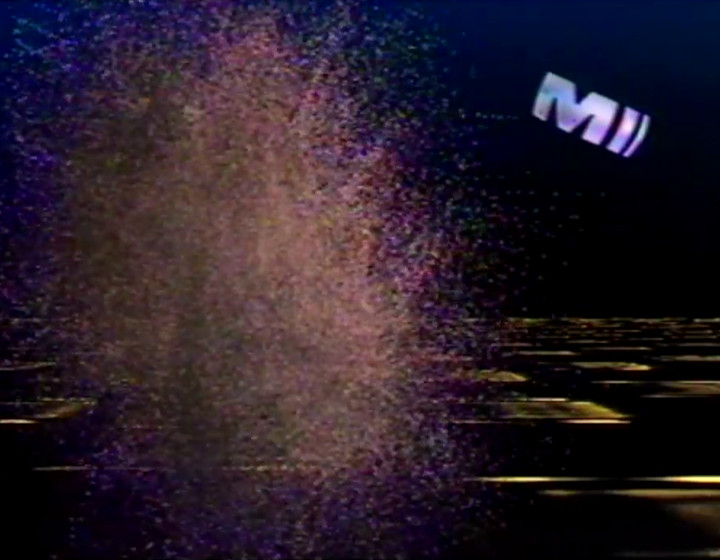
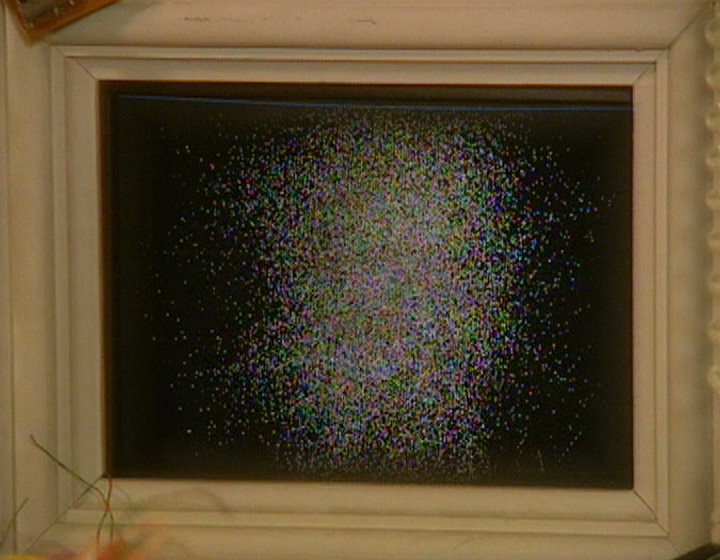
At this point, my mind was blown in much the same way as Holly’s. But there’s more. How about this segment from Tomorrow’s World (TX: 30/12/82)1, for instance?
What happens at 2:49? Well, see if you can guess. Clearly, exploding the image was a signature effect of the Mirage.
And that’s what I really love about this. In 1990, when “White Hole” was made, the Quantel Mirage was already eight years old. The year before, when Series III was made, Red Dwarf had already made use of Harry, a later, more advanced bit of kit from Quantel. If it’s overstating things to say that the Mirage was old by this point, it most definitely wasn’t new, groundbreaking kit.
Red Dwarf makes the effect look great, though. Far better than either the example in the demonstration video, or in Tomorrow’s World. And it’s better because the effect works perfectly to tell the story. Holly is being dismantled to her very essence in order to increase her IQ; her visage being blown to smithereens and then put back together is a brilliant way to portray this.
A standard Quantel effect, turned into story. That’s some of yer actual, real television magic.
UPDATE (14/12/21): Some days, silly things I write lead to the most wonderful revelations. Here’s a remarkable piece of information on this effect, from the creator themselves:
I was personally responsible for creating that effect. And it was all a mistake. The Mirage stored the shape “map” on a hard disk. And due to a bug in my software, it read a bit of uninitialised disk, which produced that effect. By the next day, it wasn’t a bug, it was a feature.
— Alec Cawley (@randombler) November 27, 2021
I think I just need Dirty Feed to be a big list of bullet points stating topics I’m interested in, and then people who are actually clever can fill in the rest.
The YouTube upload itself only said “1982”, so I thought I’d research the full date for you. Don’t ask me why the video is cropped to widescreen either, despite being uploaded by the BBC. I haven’t a clue. ↩
It’s odd, the stuff you just make up in your head about a TV programme, without any actual evidence. Even a programme you’re supposed to know plenty about.
Take Series III of Red Dwarf. Out goes Paul Montague as Production Designer, and in comes Mel Bibby. The look of the show changes almost completely, the grey submarine aesthetic replaced by cream, Alien-inspired sets. At first glance, the show could barely look much different.
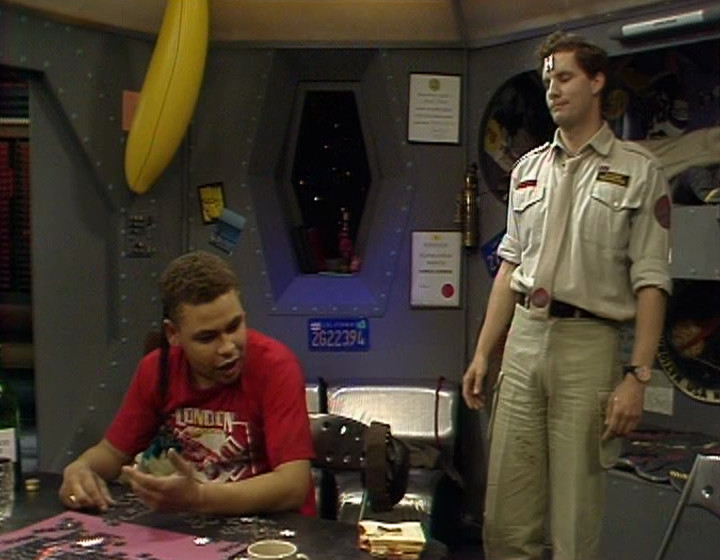
Series 2 bunkroom
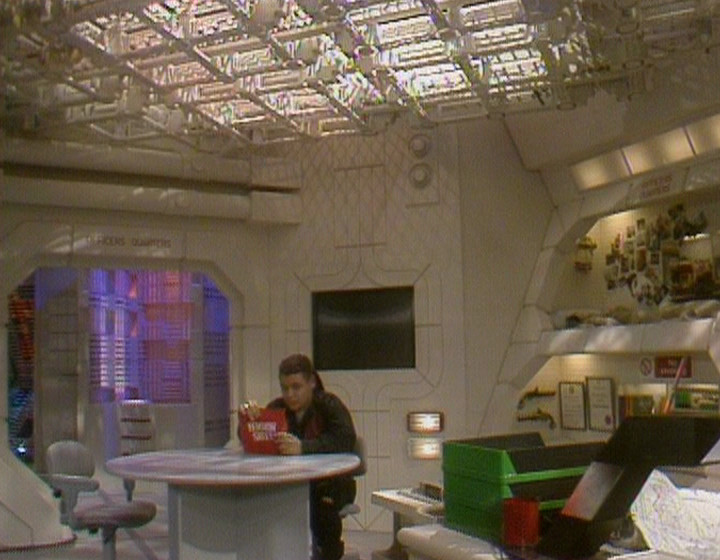
Series III bunkroom
And so, over the years, your mind runs away with itself. You imagine Mel Bibby getting a massive skip, chucking every single last shred of the old sets into it, and starting from scratch. After all, not only do the sets look entirely different, but it’s on record that the show’s new producers – a certain Rob Grant and Doug Naylor – hated the old sets.
Nobody’s ever actually said that no part of the old sets remained in the new look. But clearly they didn’t, right? The new regime would want nothing to do with them.
Series IV of Red Dwarf in 1991 saw many interesting developments. For a start, the show moved down south from BBC Manchester to Shepperton. For another, Grant Naylor Productions took control of the show. There’s a whole wealth of important things to write about.
So I want to talk about some fish.
You know the ones I mean. These ones, brand new for Series IV, on monitors around the ship:
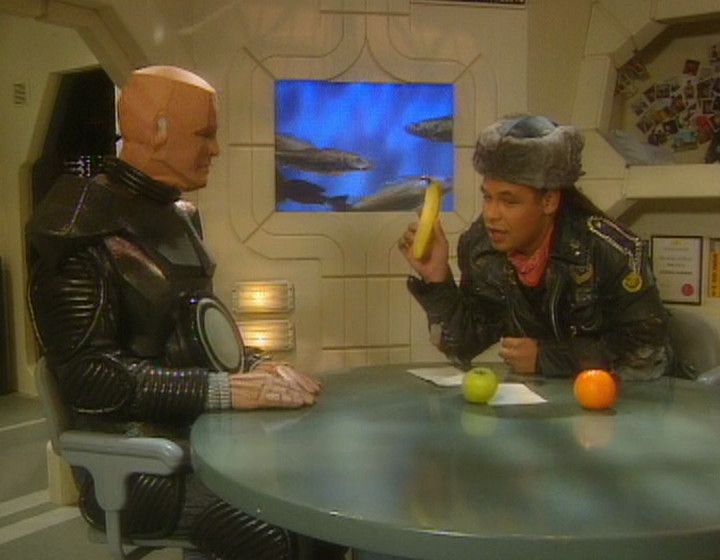
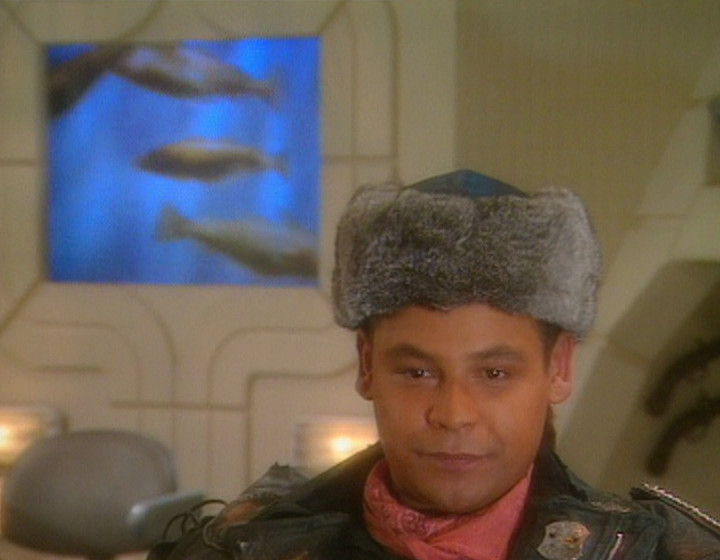
Our question today: where did this footage come from? Surely it wasn’t shot specifically for Red Dwarf?
Reshoots. The problem is always damn reshoots.
Let me explain. Over the last few years, I’ve been doing various bits of research into some of the nitty gritty about Red Dwarf‘s production. (Stuff like this article on the BBC Manchester studios is the result of that.) And once you get into the really complex stuff, knowing exactly when a scene was shot starts to become important.
But no problem, right? By this point, the production dates of Red Dwarf – at least for most of the studio material – are widely known. When telling the story of Series III, for instance, we can easily thread our way through the production order of the episodes, rather than the transmission order.
The issue: reshoots. Just because the majority of an episode was shot on a particular date, it doesn’t mean all of it was. Because productions have this nasty tendency to reshoot things they think they can do a better job of, weeks down the line. Damn them.
Sometimes, finding out the true story about an old sitcom legend gets very complicated. But not always.
For instance, take this old Londonist article from 2008, as rumours swirled about the potential sale of a certain Television Centre. But don’t worry! They have an interesting “fact”.
Interesting Television Centre fact no. 1: Studio 1 is the biggest and most expensive studio in television centre. For the early series of Red Dwarf, there was no budget for any set after the production team hired it for filming so they had the hapless space team running around the exposed lighting rigs and gangways, which worked brilliantly (and cheaply) for convincing us they were on board a massive spaceship.
It’s difficult to know where to start with that paragraph. I mean, the idea that early Red Dwarf had “no budget for any set” is not even remotely true. It is also the case that the show was never recorded in Studio 1 at TV Centre. Or let’s get right to the point: Red Dwarf never recorded a single frame of material at TV Centre full stop.
To be fair to Londonist, I think I know where they got this particular misinformation from: the BBC itself. Back in 2013, I went on a tour of the soon-to-be-closed TV Centre, and sure enough, a version of this anecdote was told to me as well: the series was shot at TVC, and you could see the lighting gantries used in the finished episodes as part of the ship. Believe it or not, no, I didn’t start an argument with the tour guide. I just went back home and wrote a passive-aggressive article, obviously.
So, if Red Dwarf was never recorded at TV Centre, where was it recorded? For its first three series, the answer is: New Broadcasting House. Not the current NBH in London; this was Manchester’s New Broadcasting House, on Oxford Road.
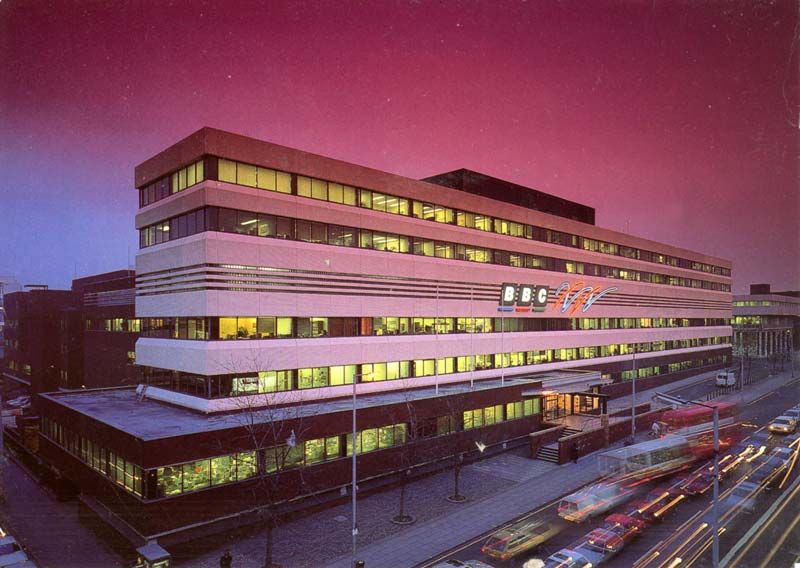
To be more specific: Red Dwarf was shot in Studio A at Oxford Road: the network production studio.1 Over the years, a great many nationally-broadcast programmes originated there; among others, the Oxford Road Show, A Question of Sport, Filthy Rich & Catflap, Cheggers Plays Pop, some editions of The Old Grey Whistle Test2, and a particular childhood favourite, The Satellite Show. And that’s only scraping the surface. Oxford Road Show aside, I expect plenty of viewers had no idea any of those series came from Manchester.
Still, for all the misinformation about Red Dwarf being shot at TV Centre, or having “no budget for any set”, the tales from the BBC tour guides were correct in one respect: certain scenes from the show really were shot on the lighting gantries in Studio A, standing in for the ship itself. Which is indeed an actual INTERESTING FACT.
Let’s take a look.
Studio B was the smaller regional production studio, although this was also used for some daytime network programming such as Open Air and Daytime UK. ↩
I have to be honest, before researching this article, I thought that The Old Grey Whistle Test always came from TV Centre. But no. Here’s one of the first television performances by Dire Straits, transmitted live from Manchester’s Studio A. ↩
For years, we didn’t know the true story of how Red Dwarf‘s first episode was made. Not really.
I mean, we thought we did. Blah blah script rejected by the BBC for years, blah blah eventually accepted at BBC Manchester, blah blah electrician’s strike, blah blah remounted in late 1987, blah blah atom bomb. We also knew the rough pattern for the recordings: rehearse at Acton for four days, go up to Manchester for two days of recording – a pre-record day on the Saturday, then the audience record day for the Sunday. Then most people had Monday off, and then back to work rehearsing the next episode on Tuesday. Simple.
That is, until the big revelation. In 2007, a rather curious DVD set was released. Titled Red Dwarf: The Bodysnatcher Collection, this was a grab bag full of Dwarf stuff which – for various reasons – didn’t make it onto the original DVD releases. And one of these features was a proper, in-depth documentary about Series 1 of the show.
ROB GRANT: At the end of the recording of the first series, we had a spare recording day – including a day’s pre-VT – so we could do a whole other show.
PAUL JACKSON: I knew it was there. And I think I maybe even discussed with them [Rob Grant and Doug Naylor], you know, we might have to do a seventh script, and that wasn’t really very practical. So we devised this rather cunning plan of using that last week to go back and do pick-ups for the rest of the series. And again, because the BBC worked in these blocks and then didn’t really monitor it very carefully, nobody noticed, in effect. And we just delivered six.“The Beginning”, Red Dwarf: The Bodysnatcher Collection
Most of those pick-ups were for that first episode, “The End”; in fact, well over half of the episode was reshot. And in an instant, this changed a vast chunk of what we thought we knew about the production of that first episode of Red Dwarf. From a programme recorded on the weekend of the 26th/27th September 1987, it now also became a programme where huge sections were re-recorded on the 7th/8th November 1987.
This year has ended up being a rather odd one for Dirty Feed. I initially intended to write precisely nothing for the first half of this year at all. So what better time to accidentally publish one of the most popular things I’ve ever written, and end up deeper in the sitcom salt mines than ever before?
Well, today’s little fact isn’t as good as that one. Or as good as this one. It is, however, something brand new about early Red Dwarf, and clears up a little mystery that has dogged fandom for decades. And by “dogged fandom for decades”, I mean “five or so people wondered about it every so often”.
So let’s take a look at the Series 1 episode “Balance of Power”, broadcast on the 29th February 1988. Specifically, the start of the cinema scene with the skutters.
The question is: what exactly are they watching?